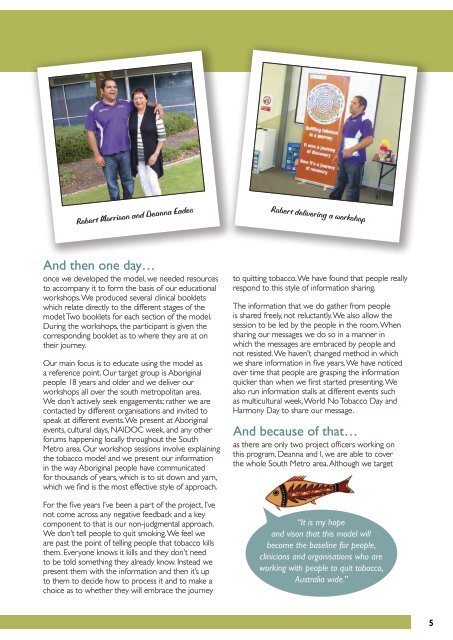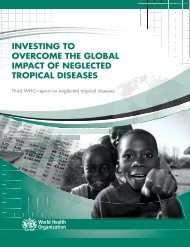INDIGENOUS STORYBOOK
The-WA-Indigenous-Storybook-7th-Edition2
The-WA-Indigenous-Storybook-7th-Edition2
Create successful ePaper yourself
Turn your PDF publications into a flip-book with our unique Google optimized e-Paper software.
Robert Morrison and Deanna Eades<br />
Robert delivering a workshop<br />
And then one day…<br />
once we developed the model, we needed resources<br />
to accompany it to form the basis of our educational<br />
workshops. We produced several clinical booklets<br />
which relate directly to the different stages of the<br />
model; Two booklets for each section of the model.<br />
During the workshops, the participant is given the<br />
corresponding booklet as to where they are at on<br />
their journey.<br />
Our main focus is to educate using the model as<br />
a reference point. Our target group is Aboriginal<br />
people 18 years and older and we deliver our<br />
workshops all over the south metropolitan area.<br />
We don’t actively seek engagements; rather we are<br />
contacted by different organisations and invited to<br />
speak at different events. We present at Aboriginal<br />
events, cultural days, NAIDOC week, and any other<br />
forums happening locally throughout the South<br />
Metro area. Our workshop sessions involve explaining<br />
the tobacco model and we present our information<br />
in the way Aboriginal people have communicated<br />
for thousands of years, which is to sit down and yarn,<br />
which we find is the most effective style of approach.<br />
For the five years I’ve been a part of the project, I’ve<br />
not come across any negative feedback and a key<br />
component to that is our non-judgmental approach.<br />
We don’t tell people to quit smoking. We feel we<br />
are past the point of telling people that tobacco kills<br />
them. Everyone knows it kills and they don’t need<br />
to be told something they already know. Instead we<br />
present them with the information and then it’s up<br />
to them to decide how to process it and to make a<br />
choice as to whether they will embrace the journey<br />
to quitting tobacco. We have found that people really<br />
respond to this style of information sharing.<br />
The information that we do gather from people<br />
is shared freely, not reluctantly. We also allow the<br />
session to be led by the people in the room. When<br />
sharing our messages we do so in a manner in<br />
which the messages are embraced by people and<br />
not resisted. We haven’t changed method in which<br />
we share information in five years. We have noticed<br />
over time that people are grasping the information<br />
quicker than when we first started presenting. We<br />
also run information stalls at different events such<br />
as multicultural week, World No Tobacco Day and<br />
Harmony Day to share our message.<br />
And because of that…<br />
as there are only two project officers working on<br />
this program, Deanna and I, we are able to cover<br />
the whole South Metro area. Although we target<br />
“It is my hope<br />
and vison that this model will<br />
become the baseline for people,<br />
clinicians and organisations who are<br />
working with people to quit tobacco,<br />
Australia wide.”<br />
5



